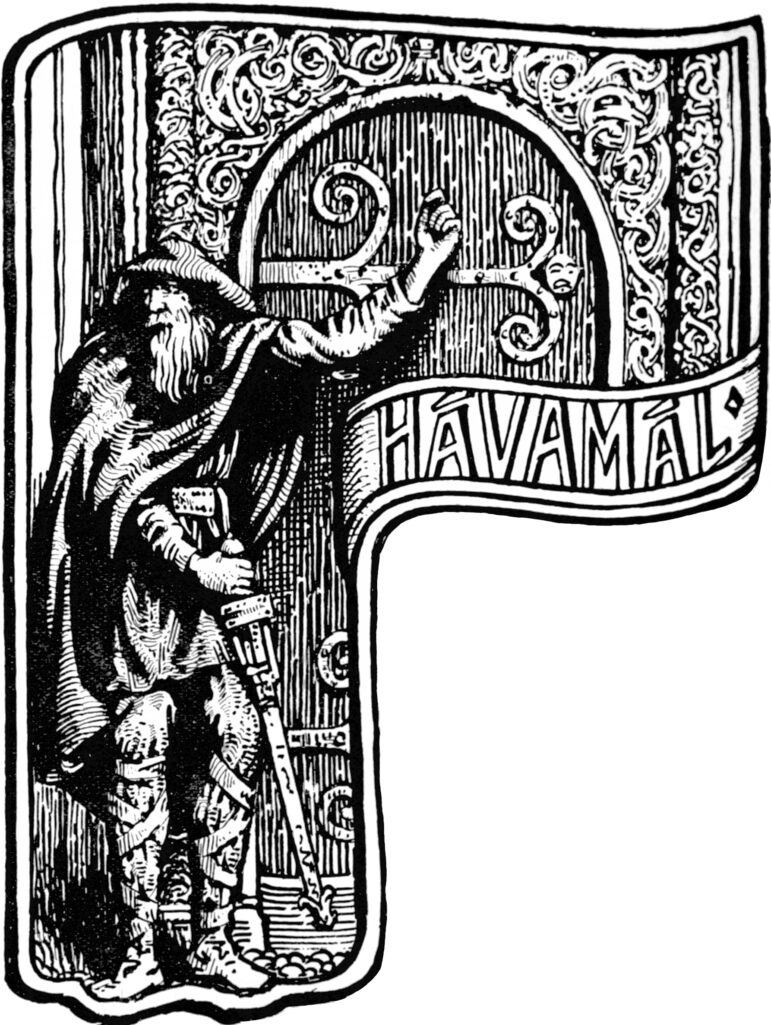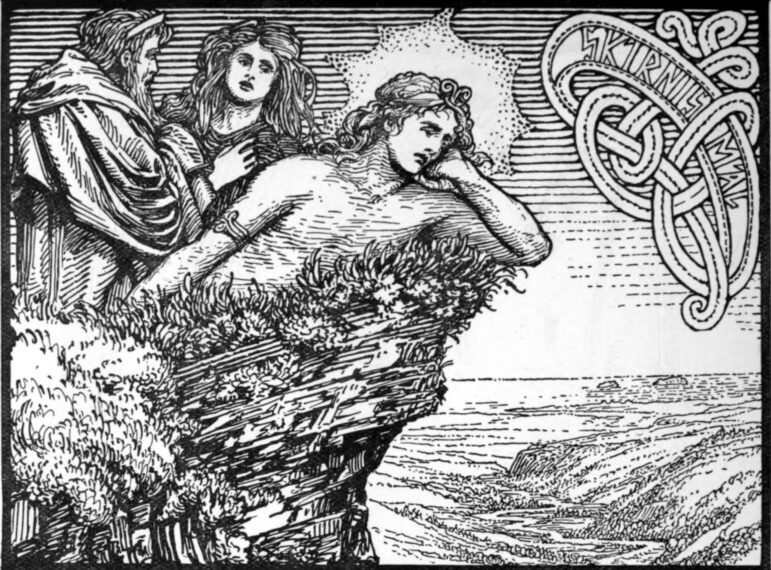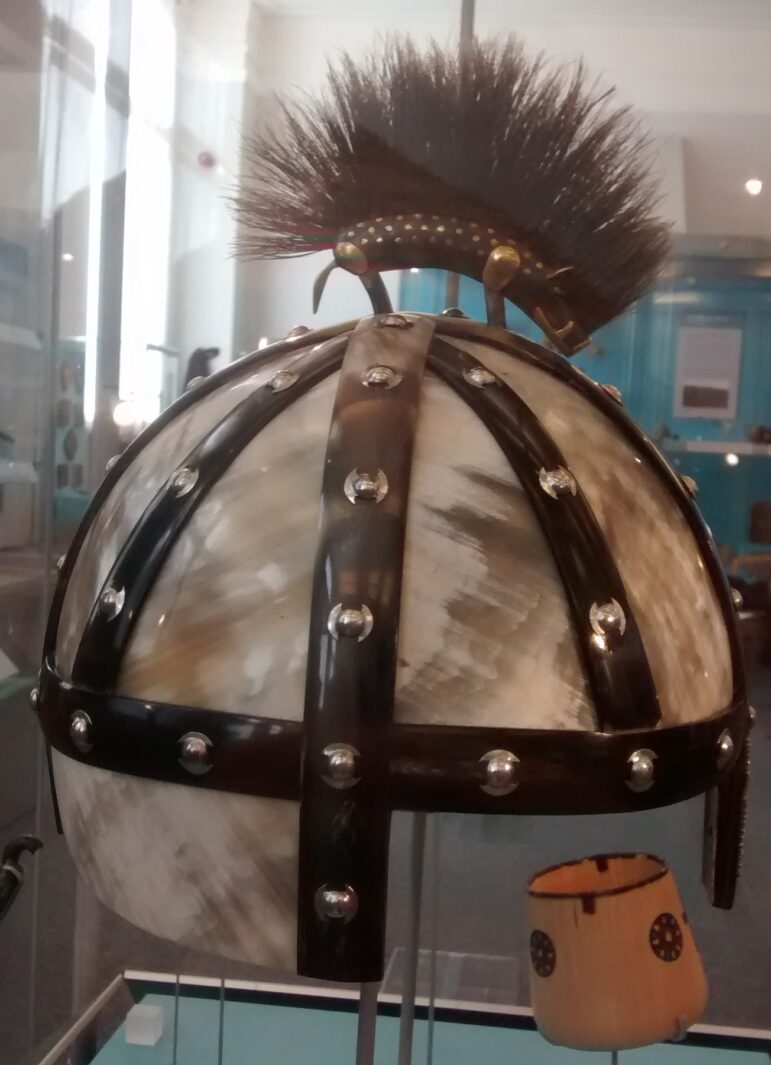
Odin lurks at the edge of the battlefield, leaning on his mystic spear and gazing at the carnage with his one eye. His wolves and ravens ravage the corpses of the dead, and he smiles darkly at the bloodshed.
Freyr sits at the center of the feast, leaning back in his high seat and sharing in the bounty of the table. His boar and his beer are shared among the gathered community, and he laughs joyously at the celebration.
If we, as practitioners of Ásatrú and Heathenry – of new religious movements inspired by old polytheistic traditions of northern Europe – venerate all the gods and goddesses, how do we reconcile these two visions of divinity?
If we honor both tribes of gods, Æsir and Vanir alike, how do we harmonize Odin’s explicit teachings on visiting violence upon our enemies with the lore of Freyr as the bringer of peace, pleasure, and prosperity?
What Odin says
Odin is complicated, to say the least.
He is a deity associated with both destruction and creativity, with spreading discord between tribes and sharing wisdom among all peoples.
He is fairly clear in his statements on destroying enemies. Or is he?

W.G. Collingwood’s illustration of Odin as Wanderer (1908) [Public Domain]
In verse 127 of the Old Norse poem Hávamál (“Sayings of the High One”), he addresses a mysterious apprentice (in Carolyne Larrington’s translation):
I advise you, Loddfafnir, to take this advice,
it will be useful if you learn it,
do you good, if you have it:
where you recognize evil, call it evil,
and give no truce to your enemies.
This verse directly inspired “Declaration 127,” a 2016 statement signed by various Heathen and Heathen-adjacent groups and individuals that purported to be an unequivocal stand against bigotry within the modern religion(s).
“We hereby declare,” it read, “that we do not condone hatred or discrimination carried out in the name of our religion, and will no longer associate with those who do.”
As I wrote at The Wild Hunt back in 2019, signatory groups did not follow through on the declaration. They continued to “do business with the AFA” (Ásatrú Folk Assembly) and associate in various ways with the leadership and membership of the neo-völkisch hate group that was specifically denounced in the declaration.
That same year, I interviewed four board members of a now-defunct American Heathen organization that had signed “Declaration 127.” When I asked if their official policies specifically forbade members of their organization “from associating with AFA members,” I received replies that varied from polite sidestepping to outright hostility.
Board Member 1: We have a non-discrimination policy in place… so I doubt that an AFA member would want to agree to our policy and join our organization.
BM 2: Our non-discrimination policy would preclude membership of an individual in any other known bigoted or discriminatory group from being a member.
BM 3: We don’t name AFA specifically, but being affiliated with groups like them would raise red flags and we do not see too many of their associates apply for membership.
BM 4: No, there’s no specific policy that we have on the books which outlaws association with AFA members. We don’t allow AFA members into our group, but it’s not our responsibility or wish to police our members’ friends. How would we enforce that, honestly? Keep tabs on everyone? Scrutinize their visible communications on social media? That sounds like some 1984 garbage that would lead to witch hunts.
“Where you recognize evil, call it evil,” says Odin, “and give no truce to your enemies.” That seems to be a fairly straightforward admonition, but modern Heathens have responded to it with an eye for theological loopholes that would make the most problematic evangelicals proud.
So, today’s practitioners clearly don’t take the words of Odin literally. As practitioners of religions the world over have done for centuries, we read loosely and metaphorically when we find something in the old lore that goes against our current worldview.
Many years ago, I noticed the very different readings by American and Icelandic Heathens of verse 41 of Hávamál:
From his weapons on open land
no man should step one pace away;
for it can’t be known for certain, out on the road,
when a man might have need of his spear.
Some Americans read it to be literally about personal ownership of weapons and embrace it in the context of Second Amendment gun-ownership issues such as concealed carry. The Icelanders generally read it to be metaphorically about wisdom and relate it to the poem’s resolute focus on wisdom, wit, knowledge, and common sense as the most valuable assets of the individual going out into the world.
We don’t simply choose to read all the lore as literal or all of it as metaphorical. We change our mode of reception depending on the passage and our perspective at the moment. What we may read literally during our first steps along the Heathen path, we may read metaphorically when we look back and reflect on the journey.
The ancient era of northern paganism was undoubtedly a violent one, and its poetry reflects that basic fact. The modern era of contemporary Heathenry is also undoubtedly violent. What matters is how we respond to that violence.
Do we read the mythological material literally and sharpen spears to stab our opponents? Or do we read the texts metaphorically and sharpen our wits in order to find new solutions for complicated conflicts?
I have always been drawn to Odin as the wandering wizard seeking wisdom over Odin as the bloodthirsty divinity fomenting battles and piling up the dead. We choose how we relate to the deities of our tradition. Our choice is not made for us by ancient poets, modern practitioners, or academic scholars.
You, as Heathens like to say, are not the boss of me.
What Freyr brings
In many ways, Freyr seems to be the polar opposite of Odin, yet ancient and modern practitioners have venerated them both – sometimes separately, sometimes together.
Freyr (along with related figures such as Fricco and Ing) is associated with peace, prosperity, protection, procreation, produce of the fields, and parting with weapons.

W.G. Collingwood’s illustration of the lovesick Freyr (1908) [Public Domain]
In his most detailed myth, Freyr sends a messenger to woo a beautiful frost giant maiden on his behalf. The story of the symbolic sunbeam of Freyr sent down to melt the icy heart of Gerdr can be easily read as a nature myth about the renewal and new growth of the earth at the springtime fading of frost, but it’s also notable that Freyr gives up his mystic sword to win the woman he loves.
Where Odin tells us – literally or metaphorically – to always keep our weapons within reach, Freyr suggests that they be cast completely aside in the face of love.
Freyr later uses an antler to fight giants, perhaps underscoring his connection to the bounty of the natural world. Nature provides what we need, when we need it. This connection is underscored in the Old Norse poem Lokasenna (“Loki’s Quarrel”), which – via symbolic figures – seems to tie Freyr to barley, beer, bees, honey, and mead.
Who among us has never enjoyed these products of nature and craft? Freyr is considered a friend to humanity for many reasons, his providing of provisions not least among them.
When the 11th century German chronicler Adam of Bremen describes the trio of sacred statues at the pagan temple in Uppsala, Sweden, he mentions that the likeness of Fricco/Freyr is fashioned “with an immense phallus.” Although I’ve met some Heathens who embrace erotic modern portrayals of a superhumanly well-endowed Freyr, we can also read the imagery as basically symbolic of Freyr’s connection to both human fertility and earthly bounty.
Those of us not directly engaged in making babies or actively harvesting from fields still benefit from healthy communities and healthy produce. We benefit even more from Freyr’s role as a bringer of peace.
Without the gift of peace, without the laying down of arms and cessation of violent conflict, it is difficult or impossible to partake of Freyr’s other gifts. When bombs are falling and snipers are shooting, how can we raise children or till the fields?
As an urban Heathen with an urban Heathen community, I don’t celebrate farmer-oriented American Ásatrú rites like “charming of the plow.” As a grandson of farmers and butchers who has neither farmed nor butchered, I feel that it would be disrespectful cosplay to pretend I’m plowing the fields for food.
On the other hand, as a Heathen of positive intent, I do believe it is incumbent upon us to work against violence in our wider communities and killing done in our name around the world. In this, I believe that venerating Freyr as bringer of peace is valid and valuable.
I’ve written before about Ásatrú ritual serving as both a model for and an agent of change. I believe that focusing rites on Freyr’s casting aside of weapons in favor of love and on his role as the bringer of peace can focus the community of practitioners on the importance of these issues to their lived lives outside of ritual time and space.
I also believe that we can honor both Odin and Freyr in an honest way that reconciles their roles in past and present pagan religions.
If you want it
Historically, both Odin and Freyr were associated with protection. There is evidence, for example, from literature and archaeology alike that the two deities were invoked by helmet designs calling upon their protective function to guard the wearer from harm.

Reconstruction of 7th-century Anglo-Saxon boar helmet [Museums Sheffield]
One basic function of mythology and religion is to provide models for behavior, both positive and negative. When we value the tales of the gods as practitioners, it’s important to embrace those tales as spaces in which we can have discussions over right and wrong action.
Given that embrace, how can we incorporate the protective role of these two deities into our own lives?
To begin with, we can use our powers of voting, volunteering, speaking, writing, and donating to provide protection for those who need it most.
We can join and support community activists, government officials, judges, authors, journalists, educators, and others who work to provide social services for those facing financial hardship, ensure bodily autonomy for all people of all genders, reduce gun violence via real laws with real enforcement and real consequences, rein in police-on-citizen brutality through independent oversight and nationwide systems, and a host of other initiatives that can have truly positive results in the lives of the people around us.
Odin and Freyr are also connected to an expansive and expanding concept of community. Despite his plotting against the giants, Odin is himself the product of a divine/giant union. Freyr falls almost comically head-over-heels in love with a female frost giant, bringing her across the embattled boundary between the warring tribes of gods and giants to join the divine community and become a goddess herself.
There is no enmity in Norse mythology more fundamental than that between the gods and giants, yet mixed marriages form the trunk of the gods’ family tree. So much for the knuckle-draggers who endlessly attempt to use the lore as cover for their Third Reich-ish pronouncements on “racial purity”!
People love whom they love, and we here in these United States live in a multicultural society – no matter how much our recidivist racialist countrymen like to shout that we don’t. To paraphrase Dr. Martin Luther King, Jr., the arc of civil society is long, but it bends towards welcoming newcomers into the American melting pot (or whatever culinary metaphor is currently preferable). When we emulate the gods literally loving their supposed enemies, we’re solidly on the right side of history.
Ancient weapon sacrifices in which the weapons were “slaughtered” by being bent and broken were made to the god who brought victory in war – if not Odin himself, then some similar divine figure. It’s probably too much to ask in this gun-obsessed society of ours, but wouldn’t it be a wonder if we were to gather up all the nation’s guns, smash them to bits, and ritually cast them into a bog? Freyr, who threw his own weapon aside forever in order to marry a girl from the other side of the tracks, would likely approve.
To approach George Orwell’s 1984 from a side opposite that of the slightly defensive American Heathen quoted above, it seems that the current White House administration is constantly forwarding the notion that “war is peace” as they keep the flow of funds and weapons freely moving in the direction of regimes openly and flagrantly committing war crimes, all but declaring that utter eradication of the enemy is the prime prerequisite to peace negotiations.
What if, as a nation, we decided to embrace Odin’s dedication to wisdom and Freyr’s focus on bringing peace? When we’ve seen over and over that terroristic acts bring bloody reprisal which leads to more terroristic acts that bring further bloody reprisal which leads to more terroristic acts, maybe it’s time to use our brains instead of our trigger fingers and seek a rational way out of the cycle of violence.
Revenge may seem emotionally satisfying, but peace comes through justice. Rather than butchering civilians or murdering children, either with nationalist terrorists or national armies, imagine if the actual perpetrators of war crimes and crimes against humanity were extracted, arrested, and held accountable in courts of law. Rather than executing medical volunteers and aid workers, imagine if we helped bring relief to the hurt and hungry. Imagine if we actually lived by the ideals that we preach.
Odin provides wisdom. Freyr provides sustenance. They bring food for mind and body, if you want it.
The Wild Hunt is not responsible for links to external content.
To join a conversation on this post:
Visit our The Wild Hunt subreddit! Point your favorite browser to https://www.reddit.com/r/The_Wild_Hunt_News/, then click “JOIN”. Make sure to click the bell, too, to be notified of new articles posted to our subreddit.